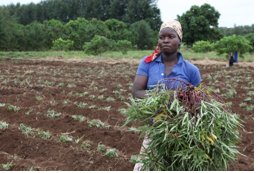Speeches Shim
OVERVIEW
Aflatoxins are pervasive in the value chains of key staple crops such as maize and groundnuts in many developing countries where agriculture is a significant contributor to Gross Domestic Product (GDP). Mozambique is one such country, where agriculture constitutes 24% of the GDP, with 80% of the population dependent on it as a source of income. Some of the most commonly cultivated crops in Mozambique, such as maize, cassava, and groundnuts, are easily contaminated by aflatoxins and widely consumed by the population. Aflatoxin exposure and its association with growth impairment in children may contribute to a significant public health burden, especially in less developed countries like Mozambique. Many studies have found strong associations between aflatoxin exposure and stunted fetal, infant, and child growth, thus providing evidence for the first criterion for causality. Mozambique is a country with high rates of chronic malnutrition (stunting), particularly in rural areas and the provinces where USAID activities linked to the Feed the Future (FTF and Preventing Child and Maternal Deaths (PMCD) initiatives are being implemented. While some data on soil and crops which show high levels of aflatoxin exist in Mozambique, there is no data on levels of aflatoxin in human serum.While the case for aflatoxin mitigation to decrease stunting is slowly being made, there is still lack of data to understand the extent of the problem at the national and sub-national level in Mozambique. Furthermore, there is very little or practically no knowledge of if and how the presence of aflatoxin in the body might interact with other risk factors of stunting, thereby exacerbating the problem.
PROGRAM DESCRIPTION
The project is carrying out a population-based assessment of the serum aflatoxin level in children under five years of age within selected rural and urban districts in Nampula. A cross-sectional survey with a sample size of 1,625 households will be conducted. The results will be representative of children under five years in 10 selected districts of Nampula, providing representative data for children 0-23 and 24-59 months of age. The study focuses on understanding the extent and level of aflatoxin exposure as measured through exposure in a serum sample of children under five years of age in the sampled households. The project also analyzes the association between aflatoxin levels and stunting, accounting for selected risk factors.
EXPECTED RESULTS/IMPACTS
The results of this study will help determine whether there is causality between aflatoxin exposure and stunted fetal, infant, and child growth. Providing unequivocal evidence that aflatoxin exposure poses a serious threat to Mozambicans, for both health and economic reasons, will further support efforts to mitigate aflatoxin in key food crops and may help reduce poverty, food insecurity, and under-nutrition in Mozambique.


Comment
Make a general inquiry or suggest an improvement.